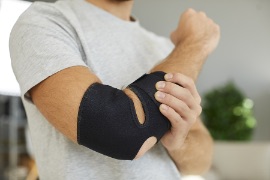Use of Braces for Injuries, Sports, and Activities
Joint and back pain are common problems that may develop due to deep tissue injuries and certain types of sports (e.g., basketball, baseball, tennis, and gaming), age-related changes, motor vehicle and work-related accidents.
 When moderate to severe pain persists, the use of a brace may be recommended to help stabilize the affected joint or area (e.g., back) during the healing process. The purpose of a brace is to help ligaments and muscles support a joint that is not working at its normal physiological capability.
When moderate to severe pain persists, the use of a brace may be recommended to help stabilize the affected joint or area (e.g., back) during the healing process. The purpose of a brace is to help ligaments and muscles support a joint that is not working at its normal physiological capability.
Braces are supportive devices that can be used to treat or prevent an injury by providing added stability to the back or joints. These devices are usually made of synthetic materials such as neoprene, spandex, or nylon, and may include metal or plastic supports and sometimes braces have
Velcro or elastic straps help customize the fit or improve the amount of stability the brace provides.
Conditions that braces are commonly used for include:
- Scoliosis
- Wrist sprains
- Ankle sprains
- Leg, ankle, or foot fractures
- Sacroiliac (SI) joint instability
- Pre- and post-operative joint or back pain
- Repetitive strain injuries (overuse injuries)
- Medial collateral ligament (MCL) sprain of the knee
- Anterior cruciate ligament (ACL) sprain or rupture of the knee
- Osteoarthritis
The main purpose of using a brace is to help relieve pain by decreasing the stress that is being placed on injured or inflamed structures. Braces provide this benefit by limiting movement of the affected region, which allows healing of the damaged tissue to occur at a faster rate or to help inhibit further joint damage. They also offer sufficient support during rehabilitation (e.g., post-injury or post-surgery). In addition, braces are typically easy to use, cost-effective, and readily available, and custom braces are available through a medical facility if required. In most cases, the use of a brace reduces the recovery period and helps to inhibit further damage—allowing individuals to return to their job, activity or sport in a shorter amount of time.
Furthermore, certain job-related duties, activities and sports activities may gradually affect the musculoskeletal system—causing unsuspected tissue damage an individual may be unaware of until the pain becomes chronic or troublesome. Using a brace as a preventative measure before, during, or after work, an activity or a sporting event can reduce the risk of injury and accelerate recovery if an unexpected injury occurs.
When Should a Brace Be Used?
If you sprain, strain, overuse, overstress, or tear certain structures in your body (e.g., ligaments, tendons, muscles), or have degenerative joint issues, such as osteoarthritis, you may be referred to a physiotherapist who can assess the damage and design an individualized rehabilitation program.
This process may be overwhelming, daunting, and painful, but it may be necessary to prevent further damage and promote healing. During this time, your physiotherapist may suggest time off from work, an activity, vigorous training, or competitive sports to allow time for the injured tissue to heal. The physiotherapist will also determine whether a brace should be worn, and will discuss the ideal type as well as the best way to use the brace.
In some cases, a physiotherapist may also recommend a custom brace. This type of brace may be particularly beneficial for joints such as the foot or ankle, especially if the brace will be worn inside shoes. Custom braces may also be designed for the back or other joints if a specific degree of stability and movement restriction is required.
If you are dealing with persistent pain in your back or a particular joint, the physiotherapists at Emerald Hills Physio & Sports Clinic can help you determine if and what type of brace may provide the most effective pain relief and support during your recovery.
If your situation requires a custom brace, your dedicated physiotherapist will walk you through this process to ensure the best fit for optimal stability. Many extended health benefit programs offer coverage for braces. Call our office today to schedule a consultation.
References
- Petersen W, Welp R, Rosenbaum D. Chronic Achilles tendinopathy: A prospective randomized study comparing the therapeutic effect of eccentric training, the AirHeel brace, and a combination of both. Am J Sports Med. 2007;35:1659-1667.
- Schott C, Zirke S, Schmelze JM, et al. Effectiveness of lumbar orthoses in low back pain: Review of the literature and our results. Orthop Rev (Pavia). 2018;10(4): 7791.
- Bishop C, Thewlis D, Hillier S. Custom foot orthoses improve first-step pain in individuals with unilateral plantar fasciopathy: A pragmatic randomised controlled trial. BMC Musculoskelet Disord. 2018;19(1):222.
- Andres BM, Murrell GAC. Treatment of tendinopathy: What works, what does not, and what is on the horizon. Clin Orthop Relat Res. 2008;466(7):1539-1554.
- Helliwell PS, Taylor WJ. Repetitive strain injury. Postgrad Med J. 2004;80(946):
438-443. - van Tulder M, Malmivaara A, Koes B. Repetitive strain injury. Lancet. 2007;369(9575):1815-1822.